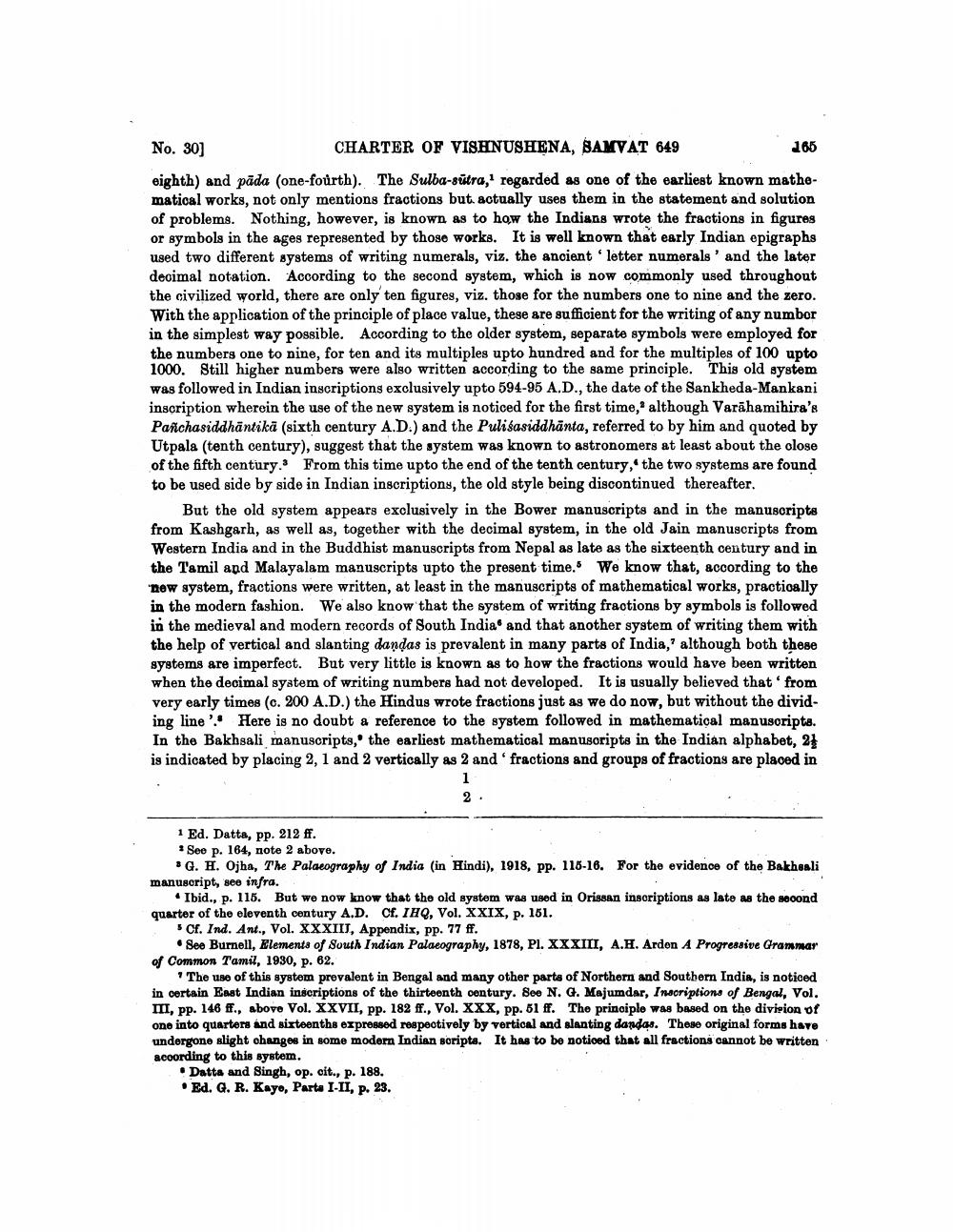________________
No. 30] CHARTER OF VISHNUSHENA, SAMVAT 649
265 eighth) and pāda (one-fourth). The Sulba-sútra,' regarded as one of the earliest known mathematical works, not only mentions fractions but actually uses them in the statement and solution of problems. Nothing, however, is known as to how the Indians wrote the fractions in figures or symbols in the ages represented by those works. It is well known that early Indian epigraphs used two different systems of writing numerals, viz. the ancient letter numerals' and the later decimal notation. According to the second system, which is now commonly used throughout the civilized world, there are only ten figures, viz. those for the numbers one to nine and the zero. With the application of the principle of place value, these are sufficient for the writing of any numbor in the simplest way possible. According to the older system, separate symbols were employed for the numbers one to nine, for ten and its multiples upto hundred and for the multiples of 100 upto 1000. Still higher numbers were also written according to the same principle. This old system was followed in Indian inscriptions exclusively upto 594-95 A.D., the date of the Sankheda-Mankani inscription wherein the use of the new system is noticed for the first time, although Varāhamihira's Panchasiddhāntikā (sixth century A.D.) and the Pulisasiddhānta, referred to by him and quoted by Utpala (tenth century), suggest that the system was known to astronomers at least about the close of the fifth century. From this time upto the end of the tenth century, the two systems are found to be used side by side in Indian inscriptions, the old style being discontinued thereafter,
But the old system appears exclusively in the Bower manuscripts and in the manuscripte from Kashgarh, as well as, together with the decimal system, in the old Jain manuscripts from Western India and in the Buddhist manuscripts from Nepal as late as the sixteenth century and in the Tamil and Malayalam manuscripts upto the present time. We know that, according to the new system, fractions were written, at least in the manuscripts of mathematical works, practically in the modern fashion. We also know that the system of writing fractions by symbols is followed in the medieval and modern records of South India and that another system of writing them with the help of vertical and slanting dandas is prevalent in many parts of India,' although both these systems are imperfect. But very little is known as to how the fractions would have been written when the decimal system of writing numbers had not developed. It is usually believed that from very early times (c. 200 A.D.) the Hindus wrote fractions just as we do now, but without the dividing line'.. Here is no doubt a reference to the system followed in mathematical manuscripts. In the Bakhsali manuscripts, the earliest mathematical manuscripts in the Indian alphabet, 2 is indicated by placing 2, 1 and 2 vertically as 2 and 'fractions and groups of fractions are placed in
2.
1 Ed. Datta, pp. 212 ff. * See p. 164, note 2 above.
*G. H. Ojha, The Palaeography of India (in Hindi), 1918, pp. 116-16. For the evidence of the Bakheali manuscript, see infra.
Ibid., p. 115. But we now know that the old system was used in Orissan inscriptions as late as the second quarter of the eleventh century A.D. Cf. IHQ, Vol. XXIX, p. 151.
Cf. Ind. Ant., Vol. XXXIIJ, Appendix, pp. 77 ff.
• See Burnell, Elements of South Indian Palaeography, 1878, Pl. XXXIII, A.H. Ardon A Progressive Grammar of Common Tamil, 1930, p. 62.
The use of this system prevalent in Bengal and many other parts of Northern and Southern India, is noticed in certain East Indian inscriptions of the thirteenth century. See N. G. Majumdar, Inscriptions of Bengal, Vol. HII, pp. 146 ff., above Vol. XXVII, pp. 182 ff., Vol. XXX, pp. 51 ff. The principle was based on the division of one into quarters and sixteenths expressed respectively by vertical and slanting dandas. These original forms have undergone slight changes in some modern Indian scripta. It has to be noticed that all fractions cannot be written acoording to this system.
• Datta and Singh, op. cit., p. 188. • Ed. G. R. Kayo, Parta I-II, p. 23.




